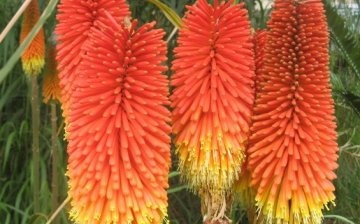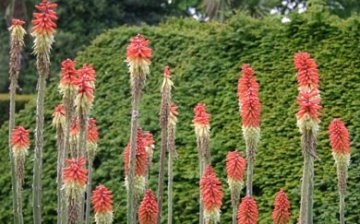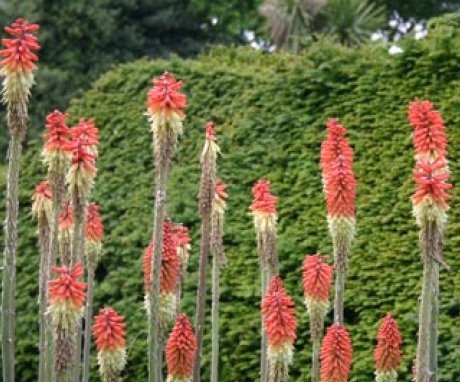Berry knifofia. Exotic that does not require the impossible ...
There are such exotic plants, looking at which you would not think that they can be grown in your own garden, for example, without using supernatural efforts. These include berry Knifofia, which is the most decorative of its kind. Naturally, for its unusual flowers ...
Content:
- Berry knifofia. Description of the plant
- Cultivation of berry knifofia. Basic principles
- Types and varieties of knifophy
- Important points in growing
Berry knifofia. Description of the plant
Knifofia berry is a herb of the Asphodelivye family. There are 70 types of them in total. The homeland of this plant is rightfully considered to be southern and central Africa. Before that, he was called Tritoma. The exotic cniphophy has a thick rhizome. The leaves of the plant are very dense, narrow and long and are collected as if in a basal rosette and are very similar to the leaves of a reed. The flowers are very small, tubular, red in color. They are collected in dense inflorescences in the form of a spikelet and are located on a long leafless peduncle. Flowering occurs in the months of July-September. The flowers do not open immediately, but gradually, from the lower part of the spike. All these plants are very fond of warmth and sun. It is better to grow them in the southern regions. Only in the middle lane is it possible to land Knifofiy Tukka. It is considered winter hardy.
Cultivation of berry knifofia. Basic principles
- The soil in place should be sandy, flavored and well loosened.
- Moisture should not remain. The plant does not like this. It is important that if stagnation remains for the winter, then rhizome decay is possible. To prevent rotting, it is necessary to make good water permeability of the soil.
- Growing a plant in the middle lane - the flowers must be covered. To do this, you must first collect the leaves in a bunch and tie on top. Thus, we protect the rhizomes and the core from moisture. The ground is additionally covered with a layer of peat. On top of this bunch is covered with a newspaper cap and covered with coniferous branches. And you can also cover it with roofing material on top so that moisture does not penetrate. When planting in southern areas, it is also advisable to cover the plant. Since the plant is thermophilic. In order not to sop the leaves with roofing material, you can not cover them. It all depends on the temperature in winter.
- In the spring, the shelter is removed. Yellow and frozen leaves are shaved off.
- To make it less hassle, then this plant can be taken and moved to a pot for the winter. Leaves are also tied in a bunch and kept, for example, in the basement and water a little. And starting in May, plant it again in the ground.
- Those peduncles that have already faded should be cut off to the very bottom. You can leave a few pieces for seeds.
- After flowering, it is worth adding potash fertilizers to the ground under the flowers. The plant will survive the winter better.
Reproduction of cniphophy occurs by seeds and division of rhizomes. Seeds are planted in boxes, starting from March-April, and covered with foil. The first borings will appear in three weeks. When they grow up a little, they will need to be transplanted. Into open ground seedlings are planted in July at an interval of about 60 cm from each other. Flowering will take place in the second or third year. The division of the bush should be done in the spring. Approximately in April-May. This procedure should be repeated every five years.
Types and varieties of knifophy
- Knifofia Tukka is a plant with long leaves. The leaves grow up to 40 centimeters, and the peduncle is about 80 centimeters high and ends with a light red spike. Blooms in July, about 4 weeks.
- Knifofia Galpena is a small flower with an orange inflorescence. About 60 centimeters high.
- The berry knifofia reaches a height of 120 centimeters. A large number of yellow inflorescences gradually turn red. A very beautiful variety Grandiflora.
- There are also hybrids. Alcazar - its height is 90 centimeters. Inflorescence orange, Maid of Orleans - white flowers, Canary - peduncle 60 cm high, light yellow flowers, Fyrwerkeri - peduncle about 100 cm high, orange-red flowers, Lemon Ice - peduncle 90 cm high, gray-yellow flowers, Royal Standard - height 100 cm, yellow-red color of the inflorescence.
Knifofia is very suitable for planting in flower beds in small groups.
It will look great against the background of silvery ground covers, for example, shingle. And also agapanthus bell-shaped, irises, woolly chisel and Fassen's catnip will grow well together.
If you cut off the knifofia, then it will delight you for a very long time.
Important points in growing
- Knifofia should be planted every five years by dividing the bush;
- The plant should be planted only in high terrain, there should be a bright light;
- The area should be calm, since the plant does not like drafts;
- In spring and autumn, do not forget to feed the plants with potash fertilizers;
- If the plant freezes, place stones at the very bottom of the plant for sufficient warmth. The sun will heat them up and the plant will be warm from this;
- The plant will not withstand temperatures below -15 degrees. Therefore, if the winters are cold, then bring the plant home.
Let these tips help you in the future. Having learned something new or gleaned good advice and recommendations, the plant will delight you again and again! Good luck with your crop production!











An interesting plant. I've never seen such a flower. I would like to plant. Is it better to sow seeds directly into a flowerbed, or in a flowerpot in spring, and then seedlings into the ground?